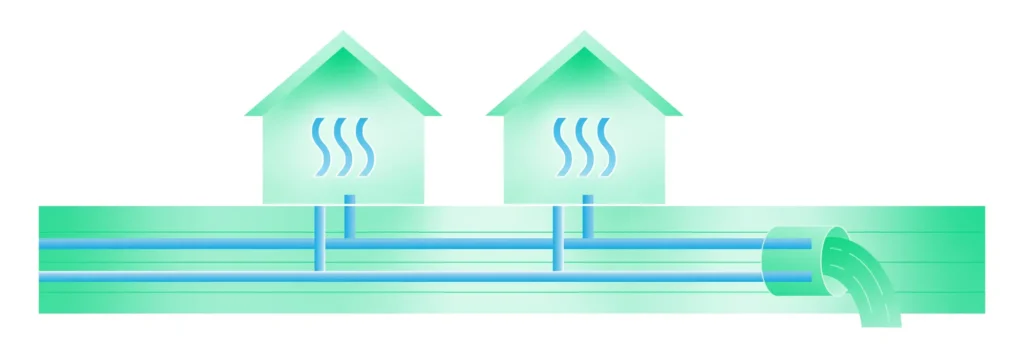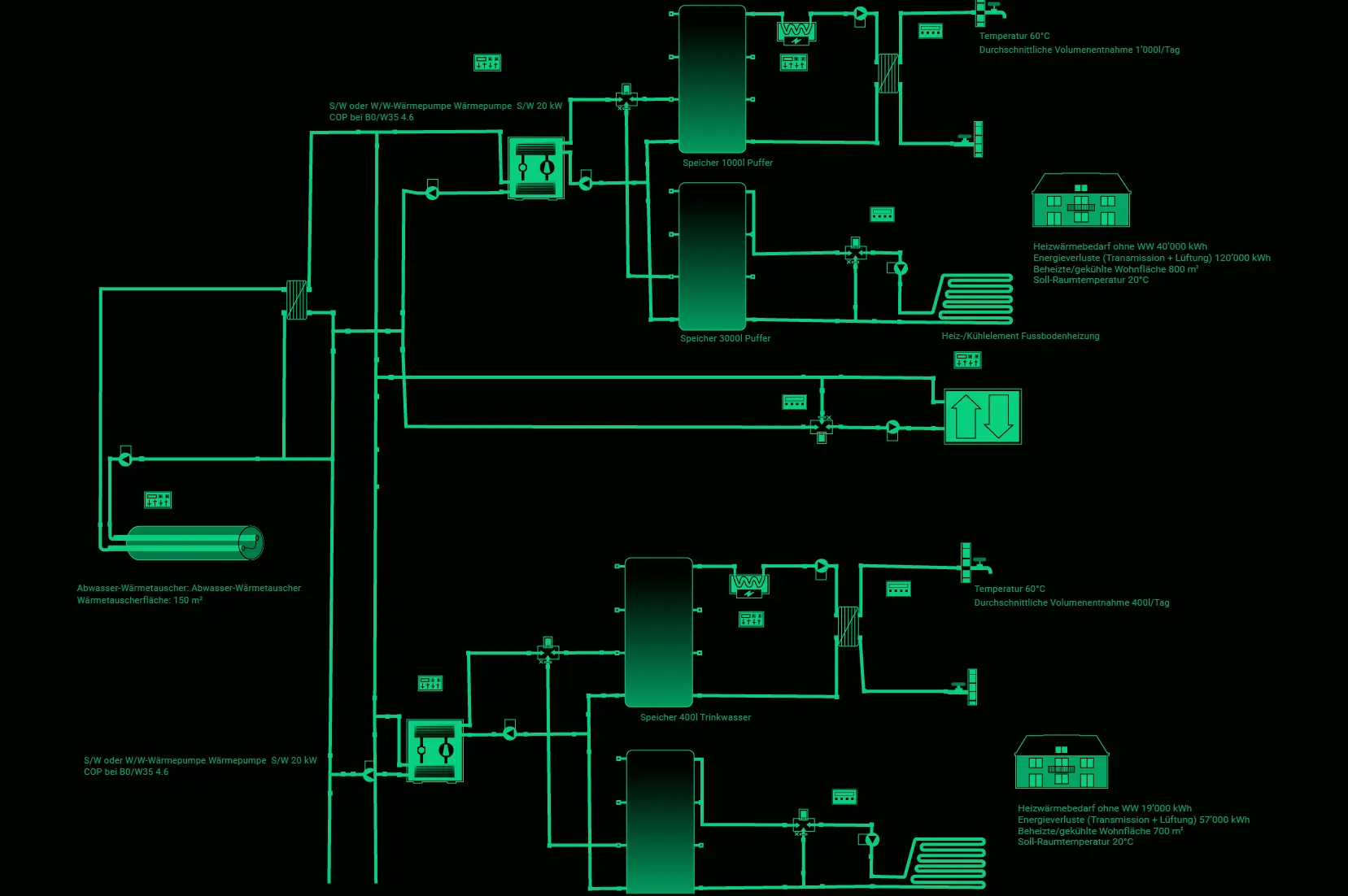
Waste Water Heat Recovery
Heat exchangers are located in sewers for waste water heat recovery. This heat is typically recovered by heat pumps and can be used to heat buildings or provide domestic hot water. This technology helps to tap unused energy potential and increase the efficiency of heating systems. Simulation is essential to fully exploit the potential of this technology and to plan the sizing of components both locally and on a project-specific basis. It allows for precise adaptation of the systems to the respective conditions and optimizes their performance.
What are waste water heat exchangers?
Wastewater heat exchangers are installations in sewer systems that capture the heat contained in wastewater and transfer it to a heating system or hot water supply. This technology uses the temperature difference between the wastewater and the heat transfer medium to ensure efficient heat transfer. Wastewater is a product of households and commercial buildings from bathrooms, kitchens and other sanitary facilities. Wastewater is also produced in industry and can be used for heat generation due to its high temperature. This makes wastewater a virtually abundant source of energy.
In a typical scenario, wastewater in the sewer is passed over a heat exchanger, which absorbs the heat from the wastewater and transfers it to the cold heat transfer medium that serves as the source for heat pumps. This process reduces the need for an external energy supply, as much of the required heat is recovered from the wastewater. In this way, wastewater heat exchangers can make a significant contribution to reducing energy consumption in buildings, while at the same time reducing environmental impact.

What are the applications for sewer heat recovery?
Wastewater heat exchangers are increasingly being used in a variety of applications, especially where other heat pump sources are not an option, such as in densely populated urban areas. As an energy source in district heating networks, they can be used to heat or cool residential, commercial and industrial buildings. If a heating network is planned, the different consumers can benefit from the synergy effects of heating and cooling with wastewater heat, especially in multi-use areas.
How can a system with a waste water heat pump be precisely dimensioned?

When planning waste water heat exchangers and heat pumps for the supply of heat networks, large buildings or commercial properties, there are many variables to consider: Temperature differences, flow rates, heat transfer rates and other thermodynamic factors. A precise simulationtool provides the ability to model and analyze these variables in order to find the best solutions for the specific requirements of a project. The simulation of wastewater heat exchangers and heat pumps brings the following added value:
- Optimize efficiency: Simulation of a wastewater heat exchanger helps maximize system efficiency. By taking into account different operating conditions – such as varying wastewater temperatures and flow rates – the system can be adjusted to perform optimally under all conditions. This maximizes heat recovery while reducing energy consumption.
- Cost savings: A detailed simulation can precisely calculate the required size and capacity of a wastewater heat exchanger. The cost-effectiveness of different solutions can be clearly analyzed by comparing variants. This leads to a cost-effective selection of components and ensures that the system does not cause expensive operating costs. The subsequent operation of the system can be made more efficient and profitable through simulations.
- Seamless integration with the heating system: Wastewater heat exchangers are often integrated into complex energy systems that include both heating systems and water heaters. Simulation is required to ensure seamless integration and the best possible operation of the systems. It is possible to test different system configurations and evaluate the effects of integrating the heat exchanger into the overall energy system.
- Increase system life: Accurate simulation allows for early identification and correction of potential problems in the operation of a wastewater heat exchanger. For example, by analyzing temperature distributions, it is possible to determine whether overheating or undercooling of the wastewater in the sewer could occur, which could cause problems in its further treatment. Simulation can be used to ensure that the system is operating efficiently and has a long service life.
Why customers use Polysun to size wastewater heat exchangers
Waste water heat exchanger in Polysun
The simulation of wastewater heat exchangers is a crucial step in the design and operation of heating networks, energy-efficient buildings and commercial facilities. By using Polysun Designer simulation software, planners and engineers can maximize the efficiency of wastewater heat exchangers and optimize their integration into complex energy systems. This not only reduces energy consumption and operating costs, but also improves sustainability and reduces environmental impact. Wastewater heat exchangers are therefore an indispensable element of modern, sustainable energy systems, and their simulation is a key tool for using this technology effectively and cost-efficiently.
FAQ
Several important factors must be considered when designing a wastewater heat exchanger:
Wastewater flow and temperature: The size and temperature of the wastewater flow will affect the choice of heat exchanger and the amount of heat recovered.
Heat demand of the building or system: Heating and hot water requirements must be included in the design.
Power source and system integration: The heat exchanger must be integrated with the existing heating and hot water system to ensure maximum efficiency.
Placement and installation: The space requirements of the heat exchanger and the ability to integrate with existing piping and infrastructure are critical.
A wastewater heat exchanger is usually integrated into the energy system by transferring heat from the wastewater to a heat pump. The heat exchanger is integrated directly into the sewer so that the heated heat transfer fluid is fed into the evaporator loop. In larger energy systems, such as commercial buildings or industrial plants, integration is often in combination with multiple energy sources, such as air heat exchangers or hybrid PVT collectors.
The main advantages of using waste water heat exchangers are:
Energy savings: By recovering heat from wastewater, the energy requirements of heat pumps can be significantly reduced.
Cost reduction: Lower energy costs by using wastewater heat.
Environmental protection: Reducing energy consumption also reduces CO2-emissions, contributing to sustainability.
Durability and ease of maintenance: Modern wastewater heat exchangers are durable and require little maintenance.
Some of the challenges in designing and installing a wastewater heat exchanger are:
Placement and integration: In existing buildings, it can be difficult to integrate the heat exchanger into the existing sewer system.
Maintenance and cleaning: Wastewater heat exchangers require regular maintenance and cleaning to maintain performance and ensure optimal heat transfer.
Temperature Limit Compliance: When designing wastewater heat exchangers, it is important to first check with the local wastewater authority to determine the limit conditions. Often, certain temperature limits must not be exceeded or undercut. In some cases, a fixed temperature differential may be specified. This must be taken into account in the operation of the heat pumps.
The simulation of a heat exchanger helps to evaluate the efficiency of the system under realistic operating conditions. Using software solutions such as Polysun Designer, designers can test different scenarios and select the best system configurations. This includes the analysis of volume flows, temperature profiles and heat transfer rates in order to optimize the system design and identify problems at an early stage.